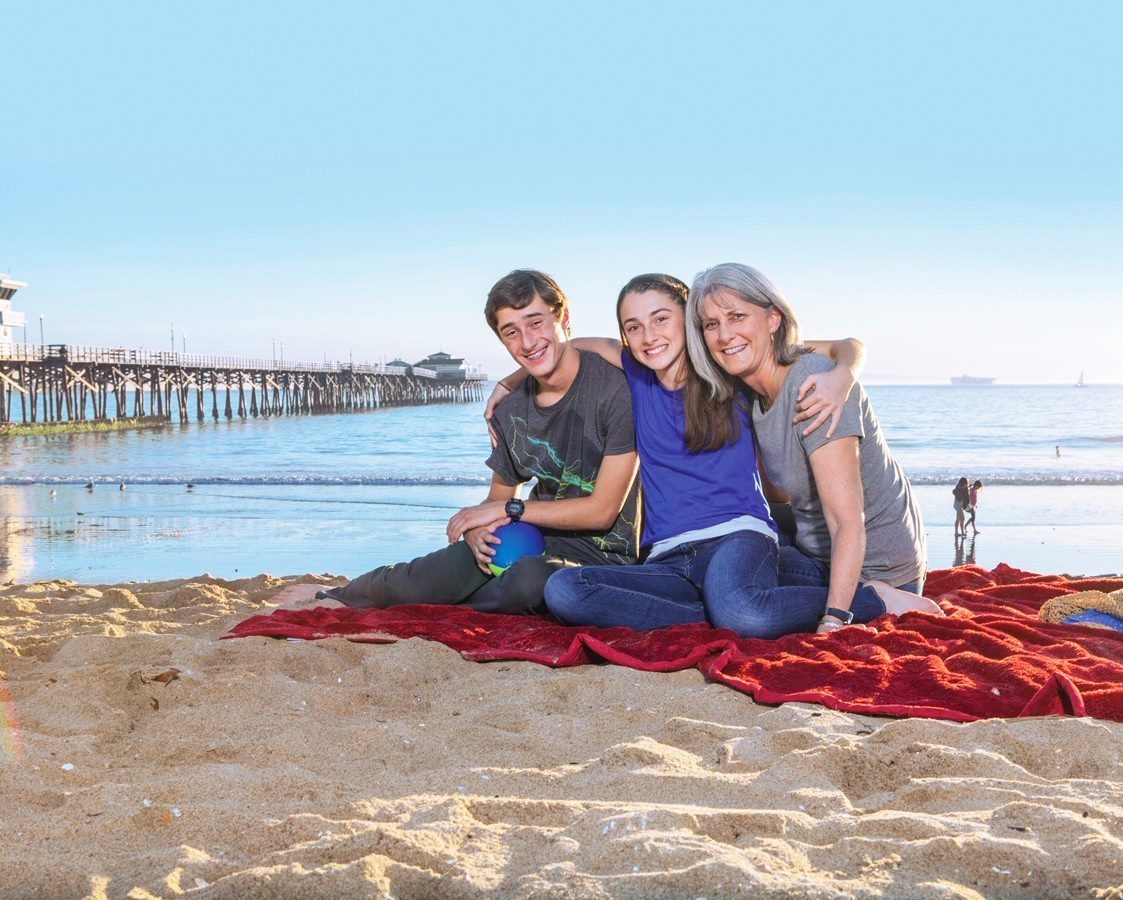Grace wasn’t the first in her family to have her spleen removed. But she’s the first with no visible scar.

On a stretch of beach, Dean chases his younger sister Grace in a friendly game of tag. As Grace coyly dodges capture by running to the water, they both decide simultaneously it’s time to body surf before the sun sets. It’s just another day for the Yacoubians.
LOOKING BACK
Until she had Dean and Grace, Cheryl Yacoubian had no idea that the so called “bad spleen” that ran in her family was actually the result of a hereditary blood disorder.
“My grandfather, my father, my brother and I all had our spleens removed,” says Cheryl. “I had the operation when I was 9-years old and it left a large, six-inch scar across my abdomen as a reminder. Needless to say, I was always self-conscious about it.”
Decades later, hematologists at Miller Children’s & Women’s Hospital Long Beach diagnosed both of her children with spherocytosis at birth. This hereditary blood disorder affects the shape of red blood cells as they pass through the spleen, often causing severe anemia, so tissues do not receive adequate oxygen.
Like Cheryl, her two children would need to have their spleens removed at a very young age. Fortunately, the splenectomy procedure had changed dramatically.
FIRST ADVANCE
When Dean was 6-years old, Nam Nguyen, M.D., pediatric surgeon, Miller Children’s, performed a laparoscopic splenectomy, or removal of the spleen. Inserting a small camera and tiny instruments through four half-inch incisions in the abdomen, Dr. Nguyen was able to perform the surgery with less post-operative pain, less risk of infection and a much shorter recovery.
“Over the last 10-15 years, laparoscopy has become the gold standard for anumber of abdominal surgeries,” says Dr. Nguyen. “It’s much less invasive than the traditional surgery that Cheryl had, and allows for patients to heal faster with minimal, less noticeable scarring.”
THE NEXT STEP
Two years after Dean’s surgery, doctors determined that it was time to remove 7-year-old Grace’s spleen. Dr. Nguyen shared with Cheryl that a single-incision laparoscopic splenectomy (SILS) had redefined the term “minimally invasive.”
“Just one tiny, single incision in the belly button is all it takes,” says Dr. Nguyen. “Now, the scar appears as just another tiny fold in the belly button. It’s barely visible.” A successful surgery followed by a two-day hospital stay meant it was time for Grace to go home. After one week, she returned to school and within two weeks, she was doing all the things that a first-grader should be able to do.
“Her energy was sky-high. Her skin was no longer pale. She was running around like nothing had ever happened,” says Cheryl.
FIT FOR A CHILD
Miller Children’s is one of just a few hospitals nationwide that offers single incision laparoscopic surgeries for removal of the spleen, gall bladder and appendix. Specialized surgeons work closely with anesthesiologists and dedicated care teams to perform virtually any evidence-based operation, all within a compassionate environment to nurture healing.
The state-of-the-art Henry L. Guenther Foundation Pediatric Surgical Center is designed exclusively for the delicate needs of infants, children and adolescents. In the anxious moments before surgery, young patients and their parents can relax in a playroom full of books, games, crafts and TVs.
Patients, and usually one parent, are walked back to the pre-op room through a hallway that is used only for in-bound surgery patients. A child going into surgery never sees a child being wheeled out, or even one who is still asleep. Anesthesia is usually introduced while the parent is still there, holding the child’s hand until he or she drifts off to sleep to a favorite movie on a TV monitor.
“We view parents as an important part of the child’s care team,” says Dr. Nguyen. “As soon as the child is awake and stable, the family is reunited, so the healing journey can begin.”
Cheryl adds, “Years ago, when I had my splenectomy, my parents were not allowed to stay with me and I think that was even more traumatic than the scar. I could not be happier with the care and attention the doctors and nurses gave to my Dean and Grace.”
NOT SCARED, NOT SCARRED
Five years post-surgery, Grace has energy to spare. After school, she studies dance, volunteers at a local animal shelter and takes care of her own eclectic menagerie of pets. Her remarkably easy splenectomy at Miller Children’s is a distant memory and there is no visible scar to remind her.


